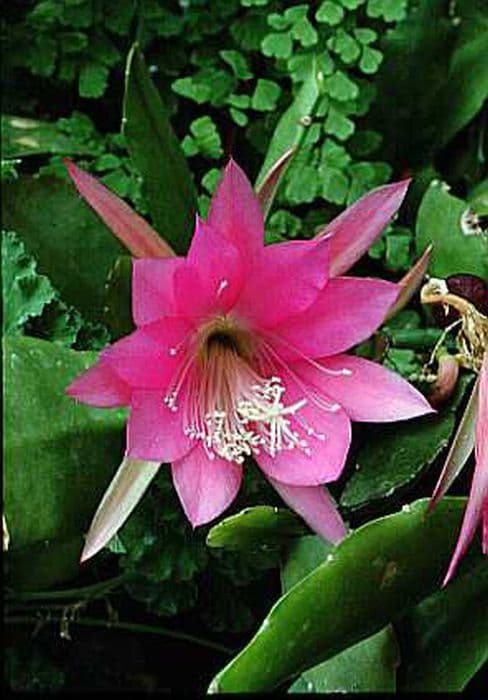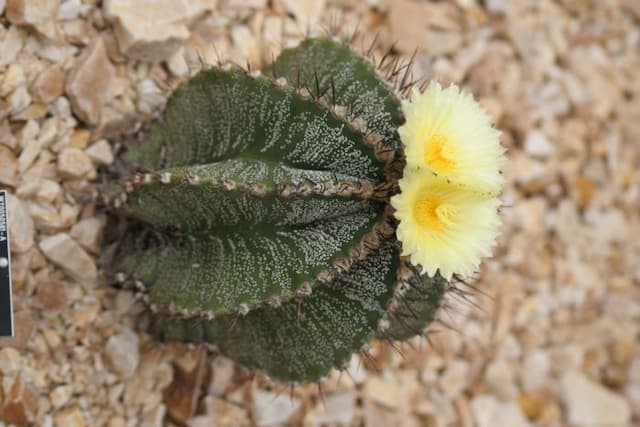Nelson's orchid cactus Disocactus nelsonii

ABOUT
The plant commonly known as Nelson's orchid cactus is an eye-catching epiphytic cactus that boasts a lush, green appearance. The stems of this cactus are narrow, elongated, and segmented, giving it a unique, almost cascading look, which is particularly well-displayed when the plant is grown in hanging baskets. Its stem segments are flat and may have slight serrations or wavy edges along their margins, adding to the plant's ornate charm. When in bloom, the Nelson's orchid cactus produces stunning flowers that are a show-stopper. These flowers are tubular and large, typically coming in hues of pink, red, or sometimes white, which can be a striking contrast to the green backdrop of the stems. The flowers themselves can be quite elaborate, with multiple layers of petals spiraling open to reveal a delicate, often fringed floral structure. The blooms also exude a pleasant fragrance, which can attract pollinators as well as the admiration of plant enthusiasts. The flowering season of this plant is a spectacle to behold and is one of the reasons this cactus is a favorite among collectors.
About this plant
 Names
NamesFamily
Cactaceae.
Synonyms
Nelson's Orchid Cactus, Nelson's Disocactus, Epiphyllum Nelsonii.
Common names
Cereus nelsonii, Aporocactus nelsonii
 Toxicity
ToxicityTo humans
Nelson's Fishbone Cactus (Disocactus nelsonii) is generally considered non-toxic to humans. There are no well-documented cases of poisoning from ingesting any part of Nelson's Fishbone Cactus, and it is not known to contain any toxins that would cause harm when touched or ingested. However, as with any plant, individual allergies or sensitivities can occur, and it is always best to avoid ingesting parts of ornamental plants due to the potential for unpredictable reactions.
To pets
Nelson's Fishbone Cactus (Disocactus nelsonii) is generally considered non-toxic to pets, including cats and dogs. It should not cause poisoning symptoms if ingested, as it is not known to contain harmful substances. However, ingestion of plant material can potentially lead to gastrointestinal upset such as vomiting or diarrhea in some pets due to mechanical irritation or sensitivity, even if the plant is not toxic. It is always a good idea to prevent pets from eating houseplants to avoid any possible issues.
 Characteristics
CharacteristicsLife cycle
Perennials
Foliage type
Evergreen
Color of leaves
Green
Flower color
Pink
Height
2 feet (0.6 meters)
Spread
2 feet (0.6 meters)
Plant type
Cactus
Hardiness zones
9
Native area
Mexico
Benefits
 General Benefits
General Benefits- Ornamental Value: Disocactus nelsonii, commonly known as the Nelson's orchid cactus, has attractive flowers that add aesthetic appeal to gardens and homes.
- Low Maintenance: This cactus requires minimal care once established, making it suitable for gardeners of all levels.
- Drought Tolerance: As a cactus, it is well-adapted to survive in periods of dryness, reducing the need for frequent watering.
- Long Blooming: The Nelson's orchid cactus has a lengthy blooming period, providing color and interest for an extended time.
- Pest Resistance: It is generally resistant to pests, reducing the need for chemical treatments.
- Suitable for Container Gardening: Due to its growth habit, it can be easily grown in pots, allowing for versatility in garden design and placement.
- Attracts Pollinators: The flowers of Disocactus nelsonii attract pollinating insects, which is beneficial for the pollination of other plants in the garden.
 Medical Properties
Medical Properties- This plant is not used for medical purposes.
 Air-purifying Qualities
Air-purifying QualitiesThis plant is not specifically known for air purifying qualities.
 Other Uses
Other Uses- Disocactus nelsonii, commonly known as Nelson's Orchid Cactus, can be used in arts and crafts due to its unique structure and vibrant flowers, providing an exotic touch to handmade decorations.
- In photography, the striking flowers of Nelson's Orchid Cactus make it a favored subject for macro photographers and nature-themed photo shoots.
- Culinary experimentation sometimes uses the flowers of this plant as edible garnishes for exotic dishes, although it is not commonly known as an edible plant.
- Horticultural education programs might utilize Nelson's Orchid Cactus as a case study for hybridization and breeding practices due to its distinctive characteristics and flower shapes.
- Some people use the stems of Nelson's Orchid Cactus to create living sculptures or topiaries by training and guiding their growth into artistic forms.
- In interior design, the sculptural aspect of the Nelson's Orchid Cactus can complement modern and minimalistic themes, adding a touch of vibrant green and floral color.
- During certain festivities like Day of the Dead, the flowers of Nelson's Orchid Cactus may be used in traditional decorations due to their vibrant and lively appearance.
- As a natural dye, the pigments from the flowers of Nelson's Orchid Cactus can be used experimentally to color textiles or artisanal crafts.
- Boutique floral shops may use Nelson's Orchid Cactus as part of exclusive arrangements or as a standalone potted specialty plant for discerning customers.
- Pet enthusiasts occasionally use safe, non-toxic plants like Nelson's Orchid Cactus as aesthetic additions to terrariums or vivariums for reptiles and amphibians, though one should always confirm safety before introducing any plant to pets.
Interesting Facts
 Feng Shui
Feng ShuiThe Nelson's fishhook cactus is not used in Feng Shui practice.
 Zodiac Sign Compitability
Zodiac Sign CompitabilityThe Nelson's fishhook cactus is not used in astrology practice.
 Plant Symbolism
Plant Symbolism- Resilience - Disocactus nelsonii, commonly known as the Nelson's Orchid Cactus, is a hardy plant that can survive in less than ideal conditions, symbolizing the ability to endure and thrive through hardships.
- Beauty in Adversity - With its striking flowers that bloom even in rough environments, the Nelson's Orchid Cactus represents the idea that beauty can exist amid adversity.
- Rarity - This plant is considered somewhat rare and unique, often symbolizing exclusivity or the preciousness of a unique trait or feature.
- Ethereal and Otherworldly - The Orchid Cactus often blooms at night, and its unique flowers can symbolize a connection to the ethereal or otherworldly realms.
 Water
WaterThe Nelson's fishbone cactus should be watered thoroughly, allowing the water to run through the drainage holes, indicating that the soil is fully saturated. In the growing season, from spring to fall, water when the top inch of soil feels dry, which may be approximately once a week, but always check the soil moisture level first. During winter, reduce watering to once every three to four weeks as the plant enters a dormancy period. The amount of water needed will vary with the size of the pot but expect to use about 8 to 16 ounces of water for small pots or up to 1/2 gallon for larger pots each time you water. It is crucial to avoid letting the plant sit in water as it can lead to root rot.
 Light
LightThe Nelson's fishbone cactus prefers bright, indirect sunlight. It thrives when placed in a well-lit room, near a window where it can receive natural light but is shielded from direct rays of the sun, especially during the harsh midday period. An east or north-facing window would be ideal, providing gentle morning sunlight without the risk of scorching the foliage.
 Temperature
TemperatureThe Nelson's fishbone cactus does best in temperatures ranging from 60 to 75 degrees Fahrenheit and can survive minimum temperatures of 50 degrees Fahrenheit. Avoid exposing the plant to temperatures below 50 degrees for prolonged periods as it can damage the plant. The cactus will appreciate being kept in a consistent temperature range and protected from drafts and extreme temperature fluctuations.
 Pruning
PruningPruning of the Nelson's fishbone cactus is done to maintain its shape, remove any dead or damaged stems, and encourage fuller growth. It is best to prune at the beginning of the growing season, typically in early spring. Use clean, sharp utensils to make cuts, and only prune as needed to shape the plant or remove unwanted sections. Over-pruning is not necessary and can be detrimental to the plant's health.
 Cleaning
CleaningAs needed
 Soil
SoilNelson's Fishing Rod prefers a well-draining soil mix with components like peat, perlite, or pine bark, and sand to ensure proper drainage. Aim for a slightly acidic to neutral pH level, around 5.5 to 7.0, for optimal growth conditions.
 Repotting
RepottingNelson's Fishing Rod should typically be repotted every 2 to 3 years or when it has clearly outgrown its current pot. This is to refresh the soil and provide space for further root growth.
 Humidity & Misting
Humidity & MistingNelson's Fishing Rod thrives in moderate to high humidity levels, ranging from 50-70%. Maintaining these humidity levels is crucial for the plant's health and flowering ability.
 Suitable locations
Suitable locationsIndoor
Place Nelson's Fishing Rod in bright indirect light with high humidity.
Outdoor
Protect Nelson's Fishing Rod from frost; partial shade is ideal.
Hardiness zone
10-11 USDA
 Life cycle
Life cycleThe life of a Nelson's Orchid Cactus (Disocactus nelsonii) begins with seed germination, which occurs best in a humid and warm environment. Once germinated, the seedlings slowly develop into young plants with characteristic elongated stems. As the plant matures, it develops segmented stems and areoles from which spines emerge. It reaches reproductive maturity after a few years and produces showy, funnel-shaped flowers that are typically white or pink, usually in the spring or early summer. After pollination, possibly involving hummingbirds or insects, the flowers develop into small, berry-like fruits containing seeds, which can be dispersed to give life to new plants. Over many years, the plant can reach a considerable size and might need support or pruning to manage its form, and it typically continues to grow and reproduce cyclically each year.
 Propogation
PropogationPropogation time
Spring-Early Summer
The most popular method for propagating the Orchid Cactus (Disocactus nelsonii) involves taking stem cuttings. Typically, the best time to do this is in the late spring or early summer when the plant is actively growing. Cuttings should be made from healthy, mature stems, taking sections about 4 to 6 inches (10 to 15 centimeters) long. After cutting, allow the ends to callous over by setting them aside in a dry, shaded area for a few days. Once calloused, the cuttings can be planted in a well-draining potting mix, about 1 inch (2.54 centimeters) deep. To stimulate root growth, it's crucial to maintain a humid environment and a steady temperature of about 70°F (21°C). Roots usually develop within a few weeks, after which the plant can continue to grow under normal care conditions.









